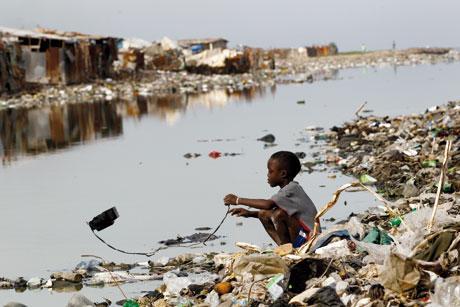
Haiti did not have a single case of cholera until October 2010 -- 10 months after a devastating earthquake leveled the country on Jan. 12 of the same year, killing up to an estimated 300,000 people.
The ensuing nightmare continued through the entire month of January, with aftershocks bringing more devastation as they rolled across the country. But, by the end of January, the horror was over, and multiple organizations were mobilized to help get the country get back on its feet - one of which was the United Nations.
The UN has been a presence in Haiti since 2004 as MINUSTAH (Mission des Nations Unies pour la stabilisation en Haïti.) After the earthquake, the UN acted to increase their presence, and three separate waves of troops arrived in Haiti on three separate days, bringing in a total of 1280 troops.
The first hospitalized case of cholera was recorded on October 17th, just days after the last batch of UN troops arrived. The spread of the disease was quickly established (in a matter of a few days) with an outbreak having started by the end of October. By mid December, there were more than 100 deaths per day. To date, the epidemic has caused nearly 10,000 deaths and has set up a presence in the country that is now well established.
But, how did it get there?
Two competing hypotheses immediately arose about how this happened. The possibilities had limits based on the bacteria's lifestyle and certain ideas could easily be ruled out. For example, the infection could not have been brought in by a mosquito. Vibrio cholerae can survive in two places: the water and our bodies.
The first hypothesis, put forth by Rita Colwell, Ph.D. was that the V. cholerae that caused the outbreak had been present in the waters surrounding Haiti before the earthquake (the environmental hypothesis.) She hypothesized that the earthquake caused enough of a disruption to the aquatic environment that the bacteria was able to enter into the drinking water of the Haitian people and cause disease.
The second hypothesis, supported by Dr. Matt Waldor, MD, was that the bacteria were brought in by the UN peacekeepers that had come from Nepal (the peacekeeper hypothesis.) V. cholerae is not only endemic in Nepal, but outbreaks had occurred there during the summer of 2010—only months before the peacekeepers arrived in Haiti.
Both of these theories make sense. Timing supports the peacekeeper hypothesis. However, just because two things occur close to each other does not mean that one caused the other. There was, at best, circumstantial evidence for either theory. Science provided the answer which lay in the DNA of the bacterial strains.
In order to understand the origin of the Haitian strain, the Waldor lab sequenced and analyzed the DNA sequence of V. cholerae strains from two patients in Haiti and found that the V. cholerae from Haiti was genetically most similar to strains found in South Asia. And, the closer the DNA sequences are, the more likely that one strain came from the other one - like paternity testing in humans. They published their findings just one year after the earthquake in January of 2011.
A second study analyzed 24 V. cholerae samples taken from patients between July and November 2010, from five different locations in Nepal, and compared them with three strains from the Haitian outbreak. This showed that the three Haitian isolates had only one or two DNA base pair differences with strains isolated from Nepal, virtually guaranteeing that the strain of bacteria found in Haiti had come from Nepal. This was published in August, 2011.
The other group, backing the environmental hypothesis also using DNA sequencing to make their case. They reported that, among the bacteria found in the stool from Haitian patients, there was a mixture of both virulent strains (dangerous to humans) and also non-virulent, more environmental strains, opening up a question mark as to which one caused the infection. However, there are major criticisms of their work including that the samples may have been taken from diarrheal disease that were not true cholera cases.
Within this debate, the scientific community decided years ago, that the data presented by the labs supporting the peacekeeper hypothesis are stronger, better and far more convincing than the environmental hypothesis. And, that is why the science led by Dr. Matt Waldor and others has been so important. The scientific community has known for years that the UN brought cholera to Haiti. There are thousands of people dead from an infectious disease that was never present in Haiti before and, it is only now, five years later, that the UN is admitting their culpability.
Quite frankly - it is too late. Cholera is in Haiti, in the water and in the people. In 2016, there have been at least 14,000 cases - the most cholera cases out of anywhere in the world. Had the UN acted quickly to vaccinate the entire country or provide clean drinking water, in 2011, upon the first publication of these results, they could have changed the course of this story. But, they resisted and, in doing so, set the country up for a public health crisis of epic proportions that has cost the lives of 10,000 people.



